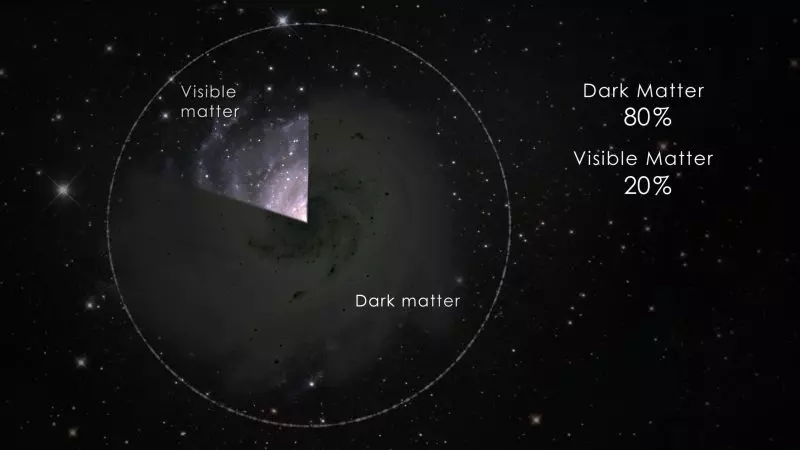This NASA image illustrates the fact that most astrophysicists think there is about four times as much dark matter as visible matter in the universe.
[Originally published as Another Unsuccessful Attempt to Detect Dark Matter]
A while ago, I wrote an article about a galaxy that has no “need” for dark matter. This is interesting, because most galaxies “need” dark matter to explain the motion of their stars.
Based on the mass that is actually observed in most galaxies, the stars should not be moving the way that they do. Thus, scientists think there must be a lot of mass in those galaxies that cannot be seen (dark matter). To make their current theories work, scientists estimate that about 80-85% of the mass in the universe comes from dark matter. Since dark matter is thought to be so prevalent in the universe, scientists have tried to detect it directly, without any luck.
How do you detect something you can’t see?
First, you have to have some idea of what you are looking for. Then, you design an experiment to see if what you think you might be looking for really exists. The most “promising” candidate for dark matter is a class of hypothetical particles called “weakly interacting massive particles” (WIMPs). These are particles that don’t interact with matter using the electromagnetic force.
Since the electromagnetic force works via the exchange of photons, if a particle doesn’t use the electromagnetic force, it produces no light. Instead, WIMPs are thought to use only the gravitational force and the weak force, which works only at the subatomic level and is responsible for most of the natural radioactivity on planet earth.
In our experience all the matter we know of uses the electromagnetic force, suggesting WIMPs are obviously strange particles. However, they are allowed by the mathematics of the standard model of physics, which is why they are considered the most “promising” of the candidates for dark matter.
How do scientist try to detect WIMPs?
The most sensitive WIMP detector is called XENON1T, which is filled with liquid and gaseous xenon. The design of the detector allows scientists to identify electromagnetic interactions that occur between particles hitting the detector and the liquid xenon inside. They discard those interactions, and what’s left should be any interactions that use only the weak force. Those, of course, would be caused by the WIMPs.
The team of scientists using XENON1T reported their latest results at a seminar on May 28th, and so far, they have not seen a signal that is consistent with what is expected for WIMPs.
I think their results argue strongly that WIMPs don’t exist, but that’s not the only explanation.
The results could also mean that physicists don’t understand WIMPs as well as they thought, and these particles actually interact more weakly with matter than what the theories tell us.
If WIMPs don’t exist, does that mean dark matter doesn’t exist? Of course not. Remember, to detect something, you have to have some idea of what you are detecting.
There are other candidates for what dark matter might be.
For a while, scientists thought that “massive astrophysics compact halo objects” (MACHOs) like neutron stars might be the answer.
That would mean dark matter is similar to the matter we already know, but it’s just too dim to see with our telescopes. The problem with MACHOs is that according to the Big Bang Model, the universe couldn’t make enough of them to account for the amount of dark matter that is supposed to be in the universe. Of course, if the Big Bang Model is wrong, perhaps dark matter is made of MACHOs.
Another candidate for dark matter is the axion.
This theoretical particle was proposed to explain very odd experimental results involving the strong nuclear force. However, if they have the right mass, they could also compose dark matter. Experiments trying to detect axions have been developed, and one has recently demonstrated that it now has the proper sensitivity, if the axions have the properties they must have for dark matter.
The Kaluza-Klein particle is another candidate for dark matter, and it’s probably the most exotic. It’s a particle that exists mostly in another dimension that we cannot see.
While this sounds like science fiction, the theory that predicts it is at least mathematically sound. That doesn’t mean it’s accurate, but it does mean it’s more than wishful thinking. Even though the particles are mostly in this other dimension, large-energy collisions should force them to decay into particles we can measure in our four dimensions (the three dimensions of space, along with the dimension of time). That’s one of the things that particle accelerators like the Large Hadron Collider are looking for.
Finally, some models suggest that the force of gravity involves the exchange of particles called “gravitons.”
Some versions of those models suggest that the graviton has a partner particle, the gravitino. If the gravitino is light enough, it could also be a candidate for dark matter. Of course, gravitons haven’t been detected, so for this to solve the dark matter problem, we have to believe in a possible partner particle of a particle that hasn’t yet been detected.
Of course, there is one more possibility: there is no dark matter at all.
Instead, it’s possible that gravity doesn’t work the way we think it does over galactic distances. Remember, most of what we know about gravity comes from experiments here on earth and in our solar system. That’s a very small scale compared to a galaxy! There are those who say that with some modifications, gravity alone can account for the motion of stars in galaxies.
So based on the science we know right now, either 80-85% of the mass in the universe is made of this mysterious stuff called dark matter (which we so far have not detected), or gravity doesn’t work the way we think it does on galactic scales. That’s why I love science! It leads to amazing conundrums that might take decades or centuries to figure out!







